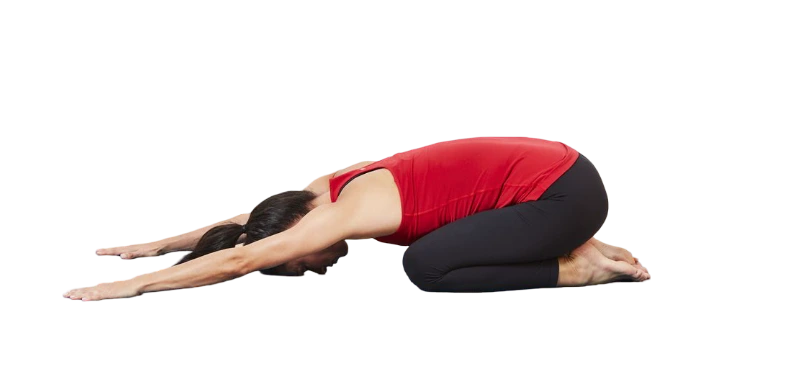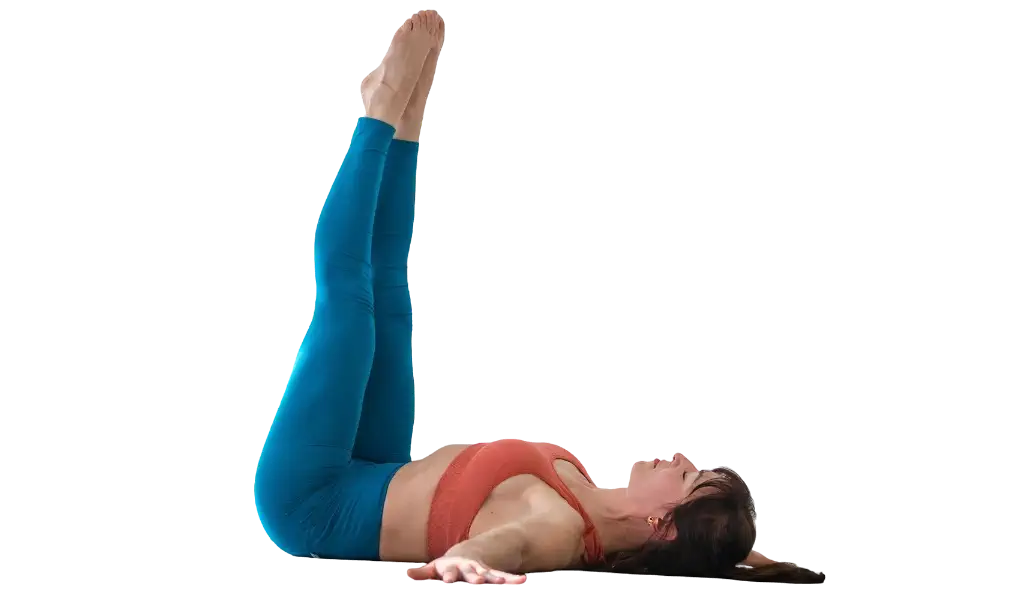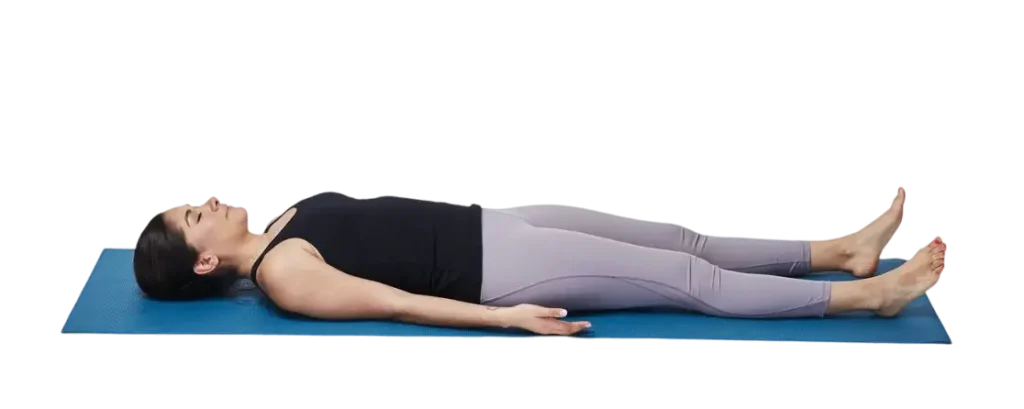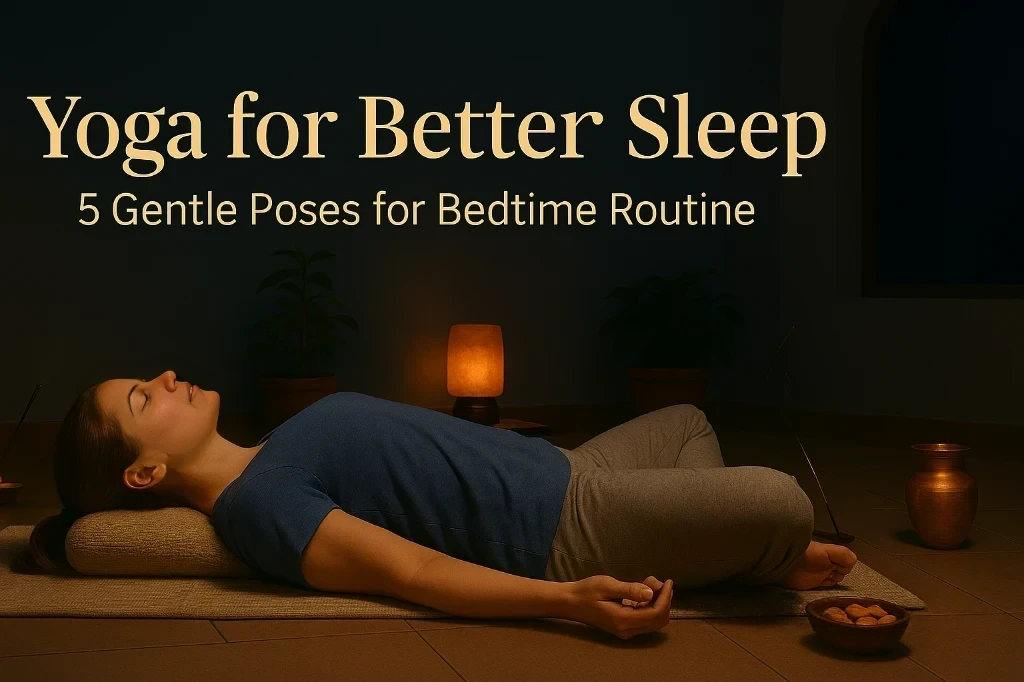You’re exhausted, but your mind doesn’t know it yet.
The lights are off, the world outside has slowed, but inside — you’re still moving.
Thoughts loop. To-do lists echo. The tension you carried through the day now clings to your shoulders, your jaw, your breath.
You try shifting your pillow. Turning over.
Checking the time. Again.
2:14 AM.
It’s a quiet kind of ache — wanting rest but not knowing how to fall into it.
And you’re not the only one.
Across cities and time zones, millions lie awake in the same silence, craving the same thing: deep, nourishing sleep. Not just hours passed under blankets, but true rest — the kind that cradles your nervous system and restores something far deeper than your muscles.
This is where yoga enters.
Not the high-energy flows or handstands you scroll past on social media — but something softer. Something slower. A kind of movement that doesn’t ask for performance, only presence.
Yoga for better sleep isn’t about doing more — it’s about doing gently.
In this post, we’ll explore five gentle yoga poses for bedtime — designed not to tire your body, but to release it. These aren’t complex or time-consuming. They’re simple invitations into stillness — easy, accessible shapes you can practice on the floor beside your bed.
You’ll discover how a few yoga stretches before sleep can shift your entire night. How a quiet bedtime yoga routine for relaxation becomes more than habit — it becomes healing.
Because rest isn’t a luxury.
It’s your birthright.
And sometimes, it just takes a few deep breaths to remember that.
Understanding the Link Between Yoga and Sleep
Sleep doesn’t just come when the body is tired — it comes when the nervous system feels safe.
This is the part we often forget.
We think sleep is a switch — off/on, tired/rested. But the truth is more nuanced.
Your body may be ready for rest.
But if your nervous system is still on guard — alert, contracted, bracing for tomorrow — sleep will feel far away.
That’s where yoga begins to do its quiet magic.
When we move through gentle shapes, breathe with intention, and let go of urgency, something shifts inside us. The sympathetic nervous system — your inner fire alarm, your fight-or-flight — finally steps back. And in its place, the parasympathetic nervous system rises — that subtle current known as rest and digest.
In this space, the body starts to soften. The heart rate slows. Muscles unclench.
The mind, once scattered, begins to gather like mist settling on a still lake.
Yoga for better sleep is not just a practice of posture — it’s a practice of permission.
Permission to stop striving.
Permission to feel, to breathe, to be held by something softer than your own expectations.
Regular yoga gently lowers cortisol — that sneaky stress hormone that keeps you wired long after the day has ended. Through conscious breath and mindful movement, yoga becomes a release valve.
Not all at once. But over time, it teaches your system how to exhale again.
And there’s another layer — body awareness.
When we’re disconnected from our bodies, we don’t notice how much tension we carry. But when you practice yoga — even the simplest poses — you begin to feel the grip in your shoulders, the clench in your hips, the fatigue behind your eyes.
And from that awareness, release becomes possible.
Unlike vigorous practices that energize and stimulate, relaxing yoga before bed works in the opposite direction.
It’s not designed to wake you up — it’s meant to bring you down.
To ground you. To return you to your breath.
Because sleep isn’t something you can chase.
But you can prepare the ground for it to arrive.
And that’s why gentle yoga poses for bedtime matter.
They don’t force stillness.
They invite it.
Preparing for Your Bedtime Yoga Routine
Before you move, you must soften the space around you.
Yoga at bedtime isn’t just about the poses — it’s about the energy you bring to them.
Rushing through a few shapes before collapsing into bed misses the point.
This is a ritual.
Not for performance. But for returning to yourself.
Start by setting the scene — your sleep sanctuary.
Dim the lights. Let shadows grow.
This gentle lowering of brightness signals your body: it’s time to shift gears.
If possible, choose a quiet room or simply turn down the noise — both around and within.
Put your phone to sleep before you try to put yourself to sleep.
Let the outside world wait.
Slip into something soft.
Loose, comfortable clothing tells your body there’s nothing left to “do” today.
If you have a yoga mat, use it. But the truth? A folded blanket or the floor beside your bed is enough.
A pillow, a bolster, a rolled-up towel — these aren’t props, they’re gestures of kindness.
Use them freely.
When to practice?
Aim for 30–60 minutes before bed — a window where the day is winding down but sleep hasn’t quite arrived.
And if you forget or resist? That’s okay. Try again tomorrow.
Consistency, not perfection, is what makes the shift.
Let this become your evening exhale.
Most importantly — come to this routine with the right heart.
Not to fix yourself.
Not to finally be “good” at rest.
But to let go of the day.
Each breath, each shape, each pause is an invitation:
Leave the noise behind. Come back to the rhythm of now.
Let your breath lead the way.
You don’t have to force anything.
You’re not here to control — you’re here to unwind.
5 Gentle Yoga Poses for Bedtime
Beautiful. Now we arrive at the heart of the practice — the poses themselves.
Not as postures to master, but as invitations to soften, surrender, and be still.
These are not flashy.
They won’t impress anyone on Instagram.
But they will meet you exactly where you are — tired, wired, seeking peace.
These are the best gentle yoga poses for sleep because they speak in whispers, not shouts.
And sometimes, that’s all your nervous system needs — a whisper saying, “It’s okay to rest now.”
1. Child’s Pose (Balasana)
There’s something ancient about this shape.
A return to the ground. A surrender to gravity.
In Child’s Pose, you let go of control. You curl inward, like a leaf folding at dusk.
Why it helps:
This pose soothes the lower back, opens the hips, and calms the brain. It gently compresses the abdomen, helping with digestion and emotional release — two things that often tangle up our sleep.

How to do it:
Kneel on the floor. Bring your big toes to touch and knees wide apart.
Slowly fold forward, extending your arms out in front of you — or, if that feels too intense, bring them back by your sides.
Let your forehead rest on the mat, the floor, or a soft pillow.
Modifications:
Tight hips? Place a rolled blanket between your thighs and calves.
Neck strain? Rest your head on stacked fists or a cushion.
How long to stay:
Hold for 1–3 minutes, or longer if it feels right.
Let your belly rise and fall against your thighs — feel the breath move you.
This isn’t hiding. This is healing.
It’s okay to feel small here.
Sometimes, the most powerful thing you can do is bow to the moment — and breathe.
2. Supine Spinal Twist (Supta Matsyendrasana)
You lie down. You exhale.
And then, like wringing out a cloth, you twist — gently releasing the stories stored in your spine.
Why it helps:
Twisting helps unwind tension from the back, hips, and digestive system. It also encourages deep breathing, stimulates circulation, and calms a restless body after a long day.

How to do it:
Lie on your back. Hug both knees to your chest.
Let your arms fall out wide, like a T.
Now drop your knees to one side while turning your head to the opposite side.
Keep both shoulders grounded.
Modifications:
Tight back or hips? Place a pillow under your top knee to support the twist.
Neck pain? Keep your gaze upward instead of twisting the head.
How long to stay:
1–2 minutes per side. Let gravity do the work.
Soften your jaw. Unclench your hands.
Let the twist untangle you.
You don’t have to think your way out of tension.
Sometimes you just have to twist and breathe.
3. Legs Up the Wall (Viparita Karani)
This isn’t a workout.
It’s a letting go.
A posture that whispers to your nervous system, “You don’t have to hold it all.”
Why it helps:
This gentle inversion allows blood and lymph to flow freely, reduces swelling in tired legs and feet, and soothes the heart rate. It nudges the body from “doing” into being.
Think of it as plugging yourself back into the Earth — but upside down.

How to do it:
Sit sideways with one hip touching a wall.
Gently lie back as you swing your legs up the wall.
Scoot your hips as close or far from the wall as feels right.
Arms can rest by your sides, or one hand on belly, one on heart.
Modifications:
Tight hamstrings? Keep a slight bend in the knees or slide a cushion under the hips.
Lower back discomfort? Try placing a folded blanket under the sacrum.
How long to stay:
Stay for 5–10 minutes — longer if it feels nourishing.
Let your breath move slow and deep.
Let your mind do nothing.
In this shape, the world softens.
The pressure lifts.
And you remember that rest is not a luxury — it’s your birthright.
4. Reclined Butterfly (Supta Baddha Konasana)
Some poses ask for effort.
This one simply asks you to receive.
Why it helps:
Reclined Butterfly is a gentle heart and hip opener.
It releases tension from the inner thighs and groin, soothes the lower belly, and invites emotional softness — especially after a long, armored day.
It’s a pose of trust, of opening without needing to chase or achieve.

How to do it:
Lie on your back.
Bring the soles of your feet together, letting your knees fall open to the sides — like the pages of a book falling open to the middle.
Place one hand on your belly, the other on your chest.
Close your eyes.
Modifications:
Support is sacred.
Place pillows or folded blankets under your knees if they hover uncomfortably.
You can also place a bolster along your spine for a supported heart opener.
How long to stay:
3–7 minutes. Let this be a space of melting.
No holding, no guarding.
Just breath meeting body in quiet reunion.
Some nights, we need to be held.
Reclined Butterfly holds you — without asking anything in return.
It reminds you that softness is not weakness.
It is a doorway.
5. Corpse Pose (Savasana)
Don’t let the name mislead you.
This is not an end —
it’s a quiet homecoming.
Why it helps:
Savasana is where the real transformation happens.
It allows the nervous system to integrate everything you’ve just done — the gentle stretching, the deep breathing, the act of slowing down.
It signals to your body: “You are safe. You can rest now.”

How to do it:
Lie flat on your back, arms a little away from the body, palms facing upward.
Let your legs fall open naturally.
Close your eyes.
Soften your jaw.
Feel the weight of your body sink into the earth beneath you.
Modifications:
Slip a pillow under your knees to relieve pressure from your lower back.
Place a folded blanket under your head, or drape one over your body for warmth and comfort.
Make it cozy — this isn’t about posture, it’s about permission.
How long to stay:
Stay at least 5 minutes.
Longer if sleep arrives while you’re here — that’s okay.
There’s no wrong way to rest.
This is the pause your soul has been craving.
The moment the doing fades, and the being begins.
Savasana isn’t about mastering stillness —
it’s about remembering that stillness was always yours.
Integrating Yoga into Your Bedtime Routine
Creating a consistent ritual around these gentle yoga poses transforms simple movements into a powerful practice for relaxation and restful sleep. It’s less about perfecting each posture and more about inviting calm into your evening.
Creating a Ritual
Begin by setting aside 20 to 30 minutes each night to move through your bedtime yoga routine for relaxation. Over time, this dedicated space becomes a gentle signal to your body and mind: It’s time to unwind. This ritual cultivates a pause between your busy day and the quiet of night.
Beyond the Poses: Breathing and Meditation
Yoga’s magic extends beyond the physical. Incorporating mindful breathing—such as diaphragmatic breath or gentle alternate nostril breathing—can deepen your state of calm. After your poses, spend a few moments in silent meditation or a body scan, tuning into sensations and releasing lingering tension. This quiet reflection anchors the mind, making the transition to sleep smoother and more natural.
Consistency is Key
Like any meaningful habit, the benefits grow with regular practice. Even on days when energy is low or time is short, doing just one or two poses can nurture your nervous system. If you find yourself drifting off mid-pose, trust that your body is receiving exactly what it needs.
Listen to Your Body
Every evening and every body is different. Honor your unique needs and feelings in the moment. Some nights may call for longer stillness, others for gentle movement. The invitation is always the same: come home to yourself with kindness.
Additional Tips for Enhancing Sleep Quality (Beyond Yoga)
While yoga is a profound tool for calming the mind and body, restful sleep often blossoms from a combination of mindful habits. Here are a few gentle practices to complement your bedtime yoga routine.
Prioritize a Consistent Sleep Schedule
Going to bed and waking up around the same time each day trains your body’s internal clock. This rhythm fosters natural sleepiness when night falls and promotes more restorative rest.
Optimize Your Sleep Environment
A cool, dark, and quiet bedroom invites the body to relax deeply. Consider blackout curtains, a fan or white noise, and comfortable bedding to create your personal sanctuary.
Limit Screen Time Before Bed
The blue light from phones, tablets, and computers interferes with melatonin production — the hormone that tells your body it’s time to sleep. Try to power down screens at least an hour before bedtime.
Avoid Caffeine and Heavy Meals Close to Sleep
Both can disrupt digestion and make it harder to settle into rest. Gentle yoga stretches before sleep can aid digestion, but pairing this with mindful eating enhances overall balance.
Embrace the Holistic Journey
Remember, improving sleep is a gradual, compassionate process. Yoga for better sleep is one part of a larger self-care path — one that honors your whole being.
Conclusion
Yoga for better sleep is not just about movement — it’s an invitation to slow down, soften, and truly arrive at the edge of your day with presence. The five gentle poses we explored — Child’s Pose, Supine Spinal Twist, Legs Up the Wall, Reclined Butterfly, and Corpse Pose — each offer a unique way to calm your nervous system and ease you into restful slumber.
By weaving these poses into a consistent bedtime yoga routine for relaxation, you give yourself the gift of peaceful nights and more grounded mornings. This practice is less about perfecting technique and more about remembering how to be — to be gentle, patient, and kind with yourself.
Tonight, when you lay down your head, consider this: you don’t need to fix yourself. You simply need to return to yourself.
I invite you to try this routine and see how it shifts your experience of bedtime. What gentle yoga stretches before sleep resonate most with you? How has yoga for better sleep transformed your nights?
Feel free to share your journey or ask questions below. And if this message found you, share it with someone who might also need a softer night.
May your nights be deep, your breath steady, and your heart quiet.
Frequently Asked Questions (FAQs)
What are the best gentle yoga poses for sleep?
The best gentle yoga poses for sleep are those that calm the nervous system without overstimulating the body. Poses like Child’s Pose, Legs Up the Wall, and Corpse Pose are especially effective for promoting relaxation and preparing the body for restful sleep.
How long should my bedtime yoga routine be?
A simple bedtime yoga routine for better sleep can range from 10 to 30 minutes. Even a short 10-minute practice focusing on gentle stretches and breath awareness can help you unwind at night.
Can yoga replace other sleep aids?
Yoga for restful sleep is a natural complement to good sleep hygiene but may not fully replace other sleep aids for everyone. It’s best used as part of a holistic approach to improving sleep quality.
Is bedtime yoga safe for everyone?
Yes, gentle yoga poses for bedtime are generally safe for most people. However, if you have specific health concerns or injuries, consult with a healthcare professional or a qualified yoga teacher before beginning any new practice.
How soon will I notice results from yoga for better sleep?
Some people feel more relaxed immediately after a bedtime yoga session, while others may notice gradual improvements in sleep quality over weeks of consistent practice.


